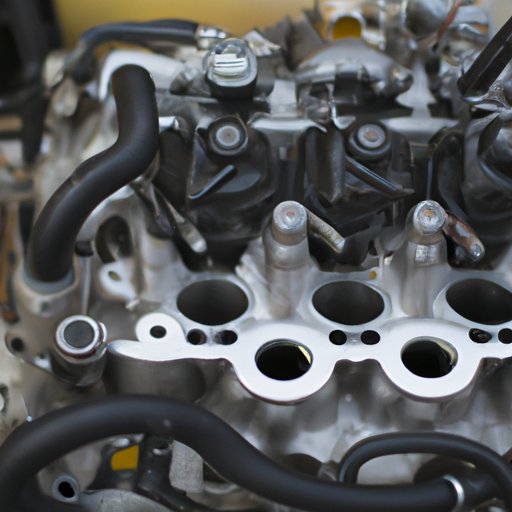Introduction
The carburetor is a key component of a vehicle’s engine, responsible for mixing air and fuel in the proper ratio so that the engine runs smoothly. Understanding how a carburetor works is essential for any car owner or mechanic. This article will provide an overview of the parts of a carburetor, explain how they work together, explore the different types of carburetors and their functions, analyze the fuel delivery system, examine the effects of tuning a carburetor, and demonstrate how to adjust a carburetor for optimal performance.
Explaining the Components of a Carburetor and How They Work Together
To understand the purpose of a carburetor, it is important to first identify its main components and explain how they work together. A carburetor consists of three main sections: the throat, the venturi, and the choke. The throat is the entry point for air and fuel, and it is where the fuel-air mixture is formed. The venturi is a narrow passage located between the throat and the choke that creates a vacuum, which draws fuel from the float chamber into the engine. The choke is a valve that restricts the flow of air, allowing the engine to start when cold.
When the throttle is opened, air flows through the throat and passes through the venturi. The vacuum created by the venturi sucks fuel from the float chamber into the throat, where it mixes with the air. This fuel-air mixture is then drawn into the engine, where it is burned to create energy.
Exploring the Different Types of Carburetors & Their Functions
There are two main types of carburetors: the single barrel and the multi-barrel. Single barrel carburetors have only one venturi and one choke, while multi-barrel carburetors have multiple venturis and chokes. Single barrel carburetors are typically used on smaller engines, as they are less complex and more cost-effective. Multi-barrel carburetors are generally used on larger engines, as they offer better control over the fuel-air mixture.
Single barrel carburetors are designed to provide a consistent fuel-air mixture regardless of engine speed. Multi-barrel carburetors, on the other hand, are designed to provide a richer fuel-air mixture at low speeds and a leaner mixture at higher speeds. This allows the engine to operate more efficiently at different speeds.

Analyzing the Fuel Delivery System of a Carburetor
In order for a carburetor to function properly, it must be connected to a fuel delivery system. This system consists of a fuel pump, a fuel filter, and a fuel line. The fuel pump is responsible for drawing fuel from the fuel tank and delivering it to the carburetor. The fuel filter prevents dirt and debris from entering the carburetor and clogging the jets. The fuel line carries the fuel from the fuel tank to the carburetor.
It is important to ensure that the fuel delivery system is functioning properly, as any impurities or blockages can result in poor engine performance. If the fuel delivery system needs to be replaced, it is best to consult a professional mechanic for assistance.

Examining the Effects of Tuning a Carburetor
Tuning a carburetor is the process of adjusting the various components to increase performance. This can be done by changing the size of the jets, altering the air/fuel mixture, or adjusting the throttle position. Tuning a carburetor can improve engine performance, but it also has some risks. If the adjustments are not done correctly, the engine may run too rich or too lean, resulting in decreased performance and increased emissions.
For this reason, it is important to understand the risks associated with tuning a carburetor and to consult a professional before attempting any adjustments. According to automotive expert John Bickford of Speed Secrets, “Tuning your carburetor can be tricky and should only be done by someone with experience.”

Demonstrating How to Adjust a Carburetor for Optimal Performance
Adjusting a carburetor requires a few basic tools, such as a screwdriver, pliers, and a vacuum gauge. Once these tools are gathered, the following steps should be taken: 1) Locate the idle mixture screws and adjust them until the vacuum gauge reads between 15 and 20 inches of mercury; 2) Check the air/fuel mixture and adjust the mixture screws if necessary; 3) Adjust the idle speed screw to achieve the desired RPM; 4) Check the choke operation and adjust if necessary.
Adjusting a carburetor can improve engine performance and efficiency. However, it is important to remember that too much adjustment can cause the engine to run too lean or too rich, resulting in decreased performance and increased emissions. Therefore, it is important to understand the risks and consult a professional if necessary.
Conclusion
The carburetor is an essential component of a vehicle’s engine, responsible for mixing air and fuel in the proper ratio so that the engine runs smoothly. In order to understand how a carburetor works, it is important to identify its main components and explain how they interact to create a fuel-air mixture. There are two main types of carburetors, single barrel and multi-barrel, and each type functions differently. Additionally, a fuel delivery system consisting of a fuel pump, a fuel filter, and a fuel line is necessary for the carburetor to function properly. Tuning a carburetor can improve engine performance, but it is important to understand the risks associated with it. Finally, adjusting a carburetor requires a few basic tools and can be done by following a few simple steps. Overall, understanding how a carburetor works is essential for any car owner or mechanic.
(Note: Is this article not meeting your expectations? Do you have knowledge or insights to share? Unlock new opportunities and expand your reach by joining our authors team. Click Registration to join us and share your expertise with our readers.)
